Skill Shortage Assessment - Panel beater - Department of Labour
Skill Shortage Assessment - Panel beater - Department of Labour
Skill Shortage Assessment - Panel beater - Department of Labour
You also want an ePaper? Increase the reach of your titles
YUMPU automatically turns print PDFs into web optimized ePapers that Google loves.
February 2005<br />
SKILL SHORTAGE ASSESSMENT<br />
OCCUPATION: PANEL BEATER<br />
Current situation: <strong>Skill</strong> shortage<br />
Short-term outlook: <strong>Skill</strong> shortage<br />
Executive summary<br />
1. The survey <strong>of</strong> employers who have recently advertised (SERA) indicates that there is<br />
currently a shortage <strong>of</strong> panel <strong>beater</strong>s in New Zealand. Only 52% <strong>of</strong> vacancies<br />
included in the survey were filled within<br />
six weeks <strong>of</strong> advertising. There was on<br />
average slightly less than one suitable<br />
applicant per vacancy. This report<br />
considers these survey results in the<br />
context <strong>of</strong> trends in the demand for and<br />
supply <strong>of</strong> panel <strong>beater</strong>s.<br />
2. Demand for panel <strong>beater</strong>s declined<br />
between 1991 and 2001, due to a drop in<br />
the number <strong>of</strong> motor accidents, a drop in<br />
the price <strong>of</strong> second-hand cars (leading to<br />
Table 1: employer survey indicators, 2004<br />
Fill rate<br />
Average<br />
number <strong>of</strong><br />
suitable<br />
applicants per<br />
vacancy<br />
<strong>Panel</strong> <strong>beater</strong>s 52% 0.9<br />
All trades<br />
surveyed<br />
41% 0.7<br />
Source: <strong>Department</strong> <strong>of</strong> <strong>Labour</strong>, SERA<br />
incentives to write <strong>of</strong>f cars that would be expensive to fix), and the adoption by panel<br />
<strong>beater</strong> firms <strong>of</strong> labour-saving repair methods. Demand is likely to have risen since<br />
2001 in line with an increase in the number <strong>of</strong> accidents. It is also likely to continue<br />
rising due to strong growth in the number <strong>of</strong> vehicles on the road and increases in the<br />
distances they travel. This may not translate into increased employment because <strong>of</strong><br />
limits on the availability <strong>of</strong> qualified panel <strong>beater</strong>s.<br />
3. The training rate (1.5%) for panel <strong>beater</strong>s (a crude measure <strong>of</strong> the rate at which the<br />
supply <strong>of</strong> fully qualified mechanics can grow through training) is lower than the<br />
average (1.8%) for all trades surveyed in New Zealand. It is also considerably lower<br />
than the equivalent training rate for panel <strong>beater</strong>s in New South Wales, Australia<br />
(3.8%). Achievements for the level 4 national certificate for panel <strong>beater</strong>s have<br />
fluctuated between 2001 and 2003. New enrolments increased over this period but<br />
total enrolments declined. It is not clear whether this will lead to an increase in the<br />
number achieving this qualification over the next few years.<br />
4. Current trends suggest that demand for panel <strong>beater</strong>s is likely to increase moderately<br />
over the next few years. While training is currently occurring at a level that is<br />
sufficient to replace those retiring from the panel <strong>beater</strong> occupation, it is not sufficient<br />
to make up for existing shortfalls and replace those leaving the occupation or moving<br />
overseas. <strong>Shortage</strong>s are therefore expected to persist in the short term.<br />
Unisys House, 56 The Terrace, PO Box 3705, Wellington, New Zealand. Tel +64 4 915 4400 Fax +64 4 915 4015 www.dol.govt.nz
2<br />
Introduction<br />
The purpose <strong>of</strong> this report is to investigate shortages <strong>of</strong> panel <strong>beater</strong>s in New Zealand.<br />
The report aims to provide an assessment <strong>of</strong> whether or not there is a shortage <strong>of</strong> panel<br />
<strong>beater</strong>s, the factors contributing to this situation and the outlook for shortages.<br />
<strong>Panel</strong> <strong>beater</strong>s, (code 72125 under the NZ Standard Classification <strong>of</strong> Occupations), are<br />
skilled tradespeople who repair vehicles damaged in accidents. Their work consists <strong>of</strong><br />
straightening bent bodies, removing dents, and replacing crumpled parts that cannot be<br />
fixed. 1 Plastic body parts are increasingly being used in new vehicles. These can also<br />
be repaired but are <strong>of</strong>ten just replaced. The <strong>Department</strong> <strong>of</strong> <strong>Labour</strong> estimates that there<br />
were approximately 3,400 panel <strong>beater</strong>s employed in New Zealand in 2003.<br />
A background and technical note to this report is available from DoL. The note provides<br />
an overview <strong>of</strong> the broader Job Vacancy Monitoring Programme, <strong>of</strong> which this report is<br />
an output. It also provides a brief description <strong>of</strong> the employer survey conducted for this<br />
report and explanations <strong>of</strong> indicators and definitions used in the report.<br />
Demand for panel <strong>beater</strong>s<br />
Historical demand<br />
Employment <strong>of</strong> panel <strong>beater</strong>s declined by 1.4% per annum between 1991 and 2001 2 .<br />
This compares with a decline <strong>of</strong> 0.2% per annum for all trades and 2.2% growth for all<br />
occupations.<br />
Table 2: employment growth <strong>of</strong> panel <strong>beater</strong>s, 1991-2001<br />
Average annual growth in employment<br />
1991-1996 1996-2001 1991-2001<br />
<strong>Panel</strong> <strong>beater</strong>s -1.7% -1.0% -1.4%<br />
All trades 0.0% -0.4% -0.2%<br />
All occupations 3.2% 1.2% 2.2%<br />
Source: Statistics New Zealand, Census <strong>of</strong> Population and Dwellings 1991, 1996 and 2001<br />
A number <strong>of</strong> factors could have contributed to the declining demand for panel <strong>beater</strong>s<br />
between 1991 and 2001. These include the following:<br />
• A decline in the number <strong>of</strong> vehicle accidents. Figure 1 shows a sizeable reduction in<br />
the number <strong>of</strong> accidents reported to police over the ten years to 2001, from a high <strong>of</strong><br />
12,163 in 1991 to a low <strong>of</strong> 8,865 in 2000.<br />
• A reduction in the price <strong>of</strong> second-hand vehicles (following the removal <strong>of</strong> import<br />
tariffs on second-hand cars in 1998). The lower replacement price encourages<br />
individuals and insurance companies to write-<strong>of</strong>f vehicles rather than repair them.<br />
1 Source: Occupational Outlook Handbook, Bureau <strong>of</strong> <strong>Labour</strong> Statistics, US and comments from SERA<br />
Intensive survey.<br />
2 Trends in employment after 2001 are only available for the broader occupational category <strong>of</strong> ‘metal<br />
moulders, sheet metal and related workers’ (NZSCO 721), from the Household <strong>Labour</strong> Force Survey<br />
(HLFS). <strong>Panel</strong> <strong>beater</strong>s are included in this group alongside coach builders, sheet metal workers, boiler<br />
makers, and fitter and welders. There is not a close association between all the constituent occupations in<br />
this 3-digit category, therefore this data source is not used in this analysis.
3<br />
• A rising tendency among panel <strong>beater</strong><br />
firms to adopt the labour-saving<br />
practice <strong>of</strong> replacing panels rather than<br />
repairing them.<br />
• The use <strong>of</strong> new materials in car<br />
manufacture, which enable minor<br />
damage to 'pop back into place'. This<br />
reduces the need for panel beating<br />
after minor accidents.<br />
Since 2000 there has been a steady rise<br />
in the number <strong>of</strong> accidents recorded in<br />
New Zealand. This has probably led to a<br />
rise in the demand for panel <strong>beater</strong>s over<br />
the last few years.<br />
Figure 1: number <strong>of</strong> crashes and vehicle fleet size, 1991-2004<br />
14<br />
Accidents<br />
4000000<br />
12<br />
Fleet vehicles<br />
3500000<br />
10<br />
3000000<br />
8<br />
2500000<br />
2000000<br />
6<br />
1500000<br />
4<br />
1000000<br />
2<br />
500000<br />
0<br />
0<br />
1991<br />
1992<br />
1993<br />
1994<br />
1995<br />
1996<br />
1997<br />
1998<br />
1999<br />
2000<br />
2001<br />
2002<br />
2003<br />
2004<br />
Source: Land Transport Safety Authority<br />
Future demand<br />
In future, demand for panel <strong>beater</strong>s will depend on a number <strong>of</strong> potentially conflicting<br />
factors. Factors which may be expected to increase the demand for panel <strong>beater</strong>s are:<br />
• An increase in the number <strong>of</strong> vehicles on the road will increase the likelihood <strong>of</strong><br />
accidents occurring. New Zealand already has one <strong>of</strong> the highest rates <strong>of</strong> car<br />
ownership in the world 3 . The number <strong>of</strong> car registrations has been growing at 3%,<br />
more than double the rate <strong>of</strong> growth in the driving age population (1%).<br />
• An increase in distances travelled (as a result <strong>of</strong> a strong economy and higher per<br />
capita disposable income) which will increase the likelihood <strong>of</strong> accidents occurring.<br />
Factors which may be expected to reduce the demand for panel <strong>beater</strong>s are:<br />
• The Government's Road Safety Strategy 2010 is expected to introduce improved<br />
safety engineering <strong>of</strong> roads, comprehensive road-safety education, and increased<br />
enforcement. Such measures will act to reduce the number <strong>of</strong> accidents, which could<br />
dampen demand for panel <strong>beater</strong>s.<br />
• There is a long-term trend towards less labour-intensive repair work on vehicles<br />
involved in crashes.<br />
On balance, the <strong>Department</strong> <strong>of</strong> <strong>Labour</strong> believes that demand for panel <strong>beater</strong>s will rise.<br />
Whether this demand will translate into an increase in the number <strong>of</strong> panel <strong>beater</strong>s<br />
employed will depend on the availability <strong>of</strong> skilled panel <strong>beater</strong>s in the labour market.<br />
Summary<br />
Demand for panel <strong>beater</strong>s declined between 1991 and 2001, due to a drop in the number<br />
<strong>of</strong> motor accidents, a drop in the price <strong>of</strong> second-hand cars (leading to incentives to write<br />
<strong>of</strong>f cars that would be expensive to fix), and the adoption by panel <strong>beater</strong> firms <strong>of</strong> laboursaving<br />
repair methods. Demand is likely to have risen since 2001 in line with an increase<br />
in the number <strong>of</strong> accidents. It is also likely to continue rising due to increased distances<br />
travelled arising from a strong economy and continued strong growth in the number <strong>of</strong><br />
vehicles on the road. Availability <strong>of</strong> skilled labour will determine whether this will translate<br />
into increased employment.<br />
3 Transport for New Zealand: overview, Ministry <strong>of</strong> Transport, April 2002
4<br />
Supply <strong>of</strong> panel <strong>beater</strong>s<br />
Training – National certificate (Level 4) qualifications and equivalent<br />
This section investigates the growth in supply <strong>of</strong> fully qualified panel <strong>beater</strong>s through<br />
training. It considers three sources <strong>of</strong> supply:<br />
1. The award <strong>of</strong> the National Certificate in Motor Industry (<strong>Panel</strong> beating) Level 4 by the<br />
Motor Industry Training Organisation (MITO). This is the nationally recognised<br />
qualification for panel <strong>beater</strong>s which is designed by MITO to meet the needs <strong>of</strong><br />
employers <strong>of</strong> panel <strong>beater</strong>s in the motor trade industry. It takes an average <strong>of</strong> three<br />
years to attain this qualification.<br />
2. The award <strong>of</strong> the National Certificate in Motor Industry (<strong>Panel</strong> beating) Level 4 by<br />
other providers such as polytechnics.<br />
3. The award <strong>of</strong> qualifications apart from national certificates which are deemed to be<br />
equivalent to the national certificate in terms <strong>of</strong> level and number <strong>of</strong> credits.<br />
Table 3 shows that the national certificate awarded by MITO represent the vast majority<br />
<strong>of</strong> qualifications at this level. The number <strong>of</strong> trainees achieving this qualification have<br />
fluctuated between 2001 and 2003. Although total enrolments have decreased between<br />
2001 and 2003, new enrolments have increased over this period. It is not clear whether<br />
this will result in an increase in the number <strong>of</strong> qualifications achieved in the future. There<br />
were no non-national certificate qualifications at the equivalent level <strong>of</strong> the national<br />
certificate awarded over this time period. A list <strong>of</strong> national certificate level 4 and<br />
equivalent qualifications and the proportion <strong>of</strong> trainees enrolled for these qualifications is<br />
provided in Appendix 1.<br />
Table 3: number <strong>of</strong> trainees enrolled in the National Certificate in Motor Industry (<strong>Panel</strong><br />
Beating) Level 4 and other equivalent qualifications<br />
2001<br />
2002<br />
2003<br />
National Certificate in<br />
Motor Industry<br />
(<strong>Panel</strong>beating) Level 4<br />
(MITO)<br />
National Certificate in<br />
Motor Industry<br />
(<strong>Panel</strong>beating) Level 4<br />
(Other providers)<br />
Other<br />
equivalent<br />
qualifications<br />
Total enrolled 345 Not available None<br />
New enrolments 117 Not available None<br />
Total enrolled 329 Not available None<br />
New enrolments 181 Not available None<br />
Total enrolled 287 20 None 307<br />
New enrolments 160 Not available None<br />
Total<br />
Source: MITO, Tertiary Education Commission (TEC)<br />
Table 4: number <strong>of</strong> trainees achieving the National Certificate in Motor Industry (<strong>Panel</strong><br />
Beating) Level 4 and other equivalent qualifications<br />
National Certificate in Motor<br />
Industry (<strong>Panel</strong>beating) Level 4<br />
(MITO)<br />
National Certificate in Motor<br />
Industry (<strong>Panel</strong>beating) Level<br />
4 (Other providers)<br />
Other<br />
equivalent<br />
qualifications<br />
Total<br />
2001 49 Not available None<br />
2002 78 Not available None<br />
2003 49 2 None 51<br />
Source: MITO, Tertiary Education Commission (TEC)
5<br />
Training rate indicators are given in table 5. A comparison <strong>of</strong> the number <strong>of</strong> trainees<br />
achieving the national certificate in panel beating (level 4) and equivalent qualifications<br />
with the number <strong>of</strong> panel <strong>beater</strong>s employed yields a training rate <strong>of</strong> 1.5%. This indicator<br />
provides a crude measure <strong>of</strong> the rate at which the supply <strong>of</strong> fully qualified panel <strong>beater</strong>s<br />
can potentially grow through training 4 . This training rate is slightly lower than the average<br />
training rate <strong>of</strong> 1.8% for all trades surveyed in New Zealand, and well below the 2003<br />
training rate <strong>of</strong> 3.7% for panel <strong>beater</strong>s in New South Wales (NSW).<br />
An alternative measure <strong>of</strong> training levels is the training enrolment rate (NC level 4) which<br />
compares the number <strong>of</strong> trainees enrolled for the national certificate with the number <strong>of</strong><br />
panel <strong>beater</strong>s employed. The training enrolment rate for panel <strong>beater</strong>s was 8.9% in<br />
2003.<br />
Training – Other related qualifications and courses<br />
While the level 4 national certificate and equivalent non-national certificates may be<br />
regarded as the qualification required to be a fully qualified panel <strong>beater</strong>, there are other<br />
lower level qualifications available in panel beating (such as MIT Certificate in Vehicle<br />
Refinishing Technology, Level 3). These qualifications may be regarded as adequate to<br />
some employers <strong>of</strong> panel <strong>beater</strong>s, especially during times <strong>of</strong> acute skill shortages. They<br />
are also <strong>of</strong> significance as these qualifications may staircase trainees towards the<br />
national certificate level 4 qualifications. Credits obtained in these qualifications may be<br />
recognised towards a national certificate level 4, should the trainee later wish to become<br />
a fully qualified tradesperson. A list <strong>of</strong> these qualifications and the number <strong>of</strong> trainees<br />
enrolled in courses leading to these qualifications is provided in Appendix 1.<br />
Training in these courses is reflected in the training enrolment rate (all related training)<br />
which compares the number <strong>of</strong> trainees enrolled in all panel <strong>beater</strong>-related training with<br />
the number <strong>of</strong> employed panel <strong>beater</strong>s. The enrolment rate (all related training) is<br />
measured at 14.1% for 2003 (table 5).<br />
Table 5: training rates for <strong>Panel</strong> <strong>beater</strong>s<br />
Indicator<br />
Explanation<br />
<strong>Panel</strong><br />
<strong>beater</strong> (NZ)<br />
All SERA<br />
trades<br />
surveyed<br />
(NZ)<br />
<strong>Panel</strong><br />
<strong>beater</strong><br />
(NSW,<br />
Australia)<br />
All trades<br />
(NSW,<br />
Australia)<br />
Training rate<br />
(national<br />
certificate L4 and<br />
equivalent)<br />
Number <strong>of</strong> trainees achieving relevant<br />
national certificates (level 4) and equivalent<br />
non-national certificate qualifications<br />
expressed as a percentage <strong>of</strong> employment<br />
in that occupation.<br />
1.5% 1.8% 3.7% 2.8%<br />
Training<br />
enrolment rate<br />
(national<br />
certificate L4 and<br />
equivalent)<br />
Training<br />
enrolment rate (all<br />
related training)<br />
Number <strong>of</strong> trainees enrolled for relevant<br />
national certificates (level 4) and equivalent<br />
non-national certificate qualifications<br />
expressed as a percentage <strong>of</strong> employment<br />
in that occupation.<br />
8.9% 16.1%<br />
Number <strong>of</strong> trainees enrolled in all relevant<br />
courses expressed as a percentage <strong>of</strong><br />
employment in that occupation. 14.1% 26.4%<br />
Source: <strong>Department</strong> <strong>of</strong> <strong>Labour</strong> (New Zealand), <strong>Department</strong> <strong>of</strong> Employment and Workplace Relations (Australia)<br />
A number <strong>of</strong> other government-funded vocational educational and training programmes<br />
(including Training Opportunities, Youth Training and <strong>Skill</strong> Enhancement Training) <strong>of</strong>fer<br />
4 This assumes that there is full employment <strong>of</strong> panel <strong>beater</strong>s. This is a reasonable assumption in the<br />
current environment <strong>of</strong> low unemployment and skill shortages.
6<br />
trades related training which lead to credit achievement on the National Qualifications<br />
Framework 5 . A further 36 people were enrolled for this training in 2003 (see Appendix 1).<br />
Training – employer perceptions<br />
Employers interviewed in the Survey <strong>of</strong> Employers who have Recently Advertised<br />
(SERA) reported that young people were not moving into the trades in sufficient<br />
numbers. Figure 2, a census age pr<strong>of</strong>ile<br />
<strong>of</strong> panel <strong>beater</strong>s confirms this. The<br />
Figure 2: age pr<strong>of</strong>ile <strong>of</strong> panel <strong>beater</strong>s<br />
percentage <strong>of</strong> panel <strong>beater</strong>s aged 15 to<br />
1000<br />
19 years decreased from 16% to 7%<br />
between 1991 and 2001. Those aged<br />
800<br />
20 to 24 years decreased from 20% to<br />
600<br />
13%. While employers were generally<br />
positive about the apprentice training<br />
400<br />
system, they stressed that panel<br />
200<br />
beating was not a job for someone with<br />
no thinking or problem solving skills.<br />
0<br />
Employers were realising that they<br />
needed to train the new generation if<br />
they were going to stem the shortage.<br />
1991 1996 2001<br />
15-19 20-24 25-29 30-34 35-39 40-44 45-49 50-54 55-59 60-64 65 +<br />
Source: Statistics New Zealand<br />
Migration<br />
Employers gave mixed reactions regarding the employment <strong>of</strong> overseas-trained panel<br />
<strong>beater</strong>s. Some reported positive experiences, while others found migrants to be an<br />
unsuitable alternative source <strong>of</strong> skilled labour, citing poor English language skills and ‘not<br />
working to New Zealand standards’ as reasons for this.<br />
Retirement<br />
It is estimated that approximately 0.8% <strong>of</strong> the panel <strong>beater</strong> workforce retires each year.<br />
This amounts to an annual loss <strong>of</strong> between 20 and 30 people.<br />
Occupational wastage<br />
Employers said that as experienced panel <strong>beater</strong>s got older, they tended to move out <strong>of</strong><br />
the trade into less physically demanding jobs such as estimation, industry sales and<br />
insurance assessment.<br />
Summary<br />
The training rate (1.5%) for panel <strong>beater</strong>s (a comparison <strong>of</strong> achievements <strong>of</strong> the national<br />
certificate level 4 and equivalent qualifications with average employment) is lower than<br />
the average (1.8%) for all trades surveyed in New Zealand. It is also considerably lower<br />
than the equivalent training rate for panel <strong>beater</strong>s in New South Wales, Australia (3.8%).<br />
The number <strong>of</strong> trainees achieving the nationally recognised qualification for panel<br />
<strong>beater</strong>s has fluctuated between 2001 and 2003. New enrolments increased over this<br />
period but total enrolments declined. It is not clear whether this will lead to an increase in<br />
achievements over the next few years.<br />
5 Enrolments in these programmes are not included in the training enrolment rate (all related training).
7<br />
Employer recruiting experiences<br />
Is there a shortage <strong>of</strong> panel <strong>beater</strong>s?<br />
The SERA results suggest that there is a shortage <strong>of</strong> panel <strong>beater</strong>s in New Zealand.<br />
Employers in the sample filled only 52% <strong>of</strong> their positions within six weeks <strong>of</strong> advertising<br />
(see table 5). This is only slightly better than that for all trades surveyed (41%). The<br />
average number <strong>of</strong> suitable applicants (0.9 per position) is slightly higher than the<br />
average for all trades surveyed (0.7 per position).<br />
Table 5: employer recruitment experiences in the SERA survey<br />
Number <strong>of</strong><br />
employers<br />
Number<br />
<strong>of</strong><br />
Positions<br />
Positions<br />
filled<br />
Fill rate<br />
Suitable<br />
applicants<br />
Average<br />
number <strong>of</strong><br />
suitable<br />
applicants<br />
<strong>Panel</strong> <strong>beater</strong> 16 23 12 52% 43 0.9<br />
All trades surveyed 240 453 186 41% 337 0.7<br />
Source: <strong>Department</strong> <strong>of</strong> <strong>Labour</strong>, SERA<br />
Employers reported being dissatisfied with the quality <strong>of</strong> the persons applying for panel<br />
beating jobs (if they had any applicants at all). They said many <strong>of</strong> the applicants did not<br />
have the skills required even though they called themselves panel <strong>beater</strong>s. <strong>Panel</strong><br />
<strong>beater</strong>s with five or more years experience were very hard to find.<br />
What are employers paying?<br />
Table 6 shows that panel <strong>beater</strong> wage rates <strong>of</strong>fered by employers in the SERA survey<br />
were close to the average wage <strong>of</strong> all trades surveyed, but considerably higher than the<br />
average wage for panel <strong>beater</strong>s measured in the <strong>Labour</strong> Cost Index (LCI). According to<br />
the LCI, wages <strong>of</strong> panel <strong>beater</strong>s rose by 8.0% in the twelve months to June 2004, which<br />
indicates that employers are responding to the shortage <strong>of</strong> panel <strong>beater</strong>s by raising their<br />
wages.<br />
Table 6: panel <strong>beater</strong> average hourly wage rates<br />
Mean<br />
SERA – panel <strong>beater</strong>s $20.43<br />
SERA – all trades surveyed $20.60<br />
LCI – panel <strong>beater</strong>s $16.90<br />
LCI – all trades $19.54<br />
Source: Statistics New Zealand (LCI), <strong>Department</strong> <strong>of</strong> <strong>Labour</strong> (SERA)<br />
Changes in market conditions<br />
As part <strong>of</strong> the SERA, employers were asked whether it was easier or harder to fill a<br />
vacancy compared with twelve months earlier. A net 50% <strong>of</strong> employers felt it was harder.<br />
Based in this evidence, the <strong>Department</strong> <strong>of</strong> <strong>Labour</strong> concludes that recruiting conditions<br />
have become more difficult for employers <strong>of</strong> panel <strong>beater</strong>s over the past year.<br />
Outlook<br />
Current trends suggest that demand for panel <strong>beater</strong>s is likely to increase moderately<br />
over the next few years. While training is currently occurring at a level that is sufficient to<br />
replace those retiring from the panel <strong>beater</strong> occupation, it is not sufficient to make up for
8<br />
existing shortfalls and replace those leaving the occupation or moving overseas.<br />
<strong>Shortage</strong>s are therefore expected to persist in the short term.<br />
For further information, contact:<br />
Hamsa Lilley, ph. 04-915 4465, hamsa.lilley@dol.govt.nz<br />
Andrew Whiteford, ph. 04-915 4568, andrew.whiteford@dol.govt.nz<br />
Disclaimer: The <strong>Department</strong> <strong>of</strong> <strong>Labour</strong> has made every effort to ensure that the information contained in<br />
this report is reliable, but makes no guarantee <strong>of</strong> its accuracy or completeness and does not accept any<br />
liability for any errors. The information and opinions contained in this report are not intended to be used as<br />
a basis for commercial decisions and the <strong>Department</strong> accepts no liability for any decisions made in reliance<br />
on them. The <strong>Department</strong> may change, add to, delete from, or otherwise amend the contents <strong>of</strong> this report<br />
at any time without notice. The material contained in this report is subject to Crown copyright protection<br />
unless otherwise indicated. The Crown copyright protected material may be reproduced free <strong>of</strong> charge in<br />
any format or media without requiring specific permission. This is subject to the material being reproduced<br />
accurately and not being used in a derogatory manner or in a misleading context. Where the material is<br />
being published or issued to others, the source and copyright status should be acknowledged. The<br />
permission to reproduce Crown copyright protected material does not extend to any material in this report<br />
that is identified as being the copyright <strong>of</strong> a third party. Authorisation to reproduce such material should be<br />
obtained from the copyright holders.
9<br />
APPENDIX 1. TRAINING ENROLMENTS FOR PANEL BEATING TRADE:<br />
2003<br />
Enrolments in National Certificate Level 4 and equivalent qualifications: 2003<br />
Qualification Title<br />
Qualification<br />
Code<br />
Provider Name Level Credits<br />
NC in Motor Industry<br />
(<strong>Panel</strong>beating) NC5381 MITO 4 198<br />
NC in Motor Industry<br />
Christchurch Polytechnic<br />
(<strong>Panel</strong>beating)<br />
NC5381 Inst <strong>of</strong> Technology 4 198<br />
Total<br />
Share <strong>of</strong><br />
Enrolments<br />
(%)<br />
93.5%<br />
6.5%<br />
100.0%<br />
Enrolments in other qualifications<br />
Qualification Title<br />
Certificate in <strong>Panel</strong> beating<br />
Trade Development<br />
NC in Motor Industry (Entry<br />
to Motor Body<br />
NC in Motor Industry - entry<br />
to motor body trades<br />
Automotive <strong>Panel</strong> beating<br />
MIT Certificate in Motor Body<br />
Technology<br />
Qualification<br />
Code<br />
HV4140<br />
NC5232<br />
NC5232<br />
PC3410<br />
MN4336<br />
Provider Name Level Credits<br />
Wellington Institute <strong>of</strong><br />
Technology 2 120<br />
Christchurch Polytechnic<br />
Inst <strong>of</strong> Tech 2 94<br />
Southern Institute <strong>of</strong><br />
Technology 2 94<br />
Fairview Educational<br />
Services Limited 3 127<br />
Manukau Institute <strong>of</strong><br />
Technology 3 120<br />
Manukau Institute <strong>of</strong><br />
Technology na na<br />
Vintage Car Restoration MN0054<br />
LCP – <strong>Panel</strong> beating "A"<br />
Grade na MITO 4 na<br />
Total<br />
Share <strong>of</strong><br />
Enrolments<br />
(%)<br />
10.1%<br />
20.1%<br />
19.0%<br />
7.3%<br />
11.7%<br />
17.3%<br />
14.5%<br />
100.0%<br />
Enrolments in Training Opportunities Programme, Youth Training and <strong>Skill</strong> Enhancement<br />
Training related to the panel beating trade<br />
Course name<br />
Intro to <strong>Panel</strong> Beating<br />
Intro to <strong>Panel</strong> Beating<br />
Total<br />
Programme<br />
type<br />
TOP<br />
YOUTH<br />
Share <strong>of</strong><br />
Enrolments<br />
(%)<br />
91.7%<br />
8.3%<br />
100.0%


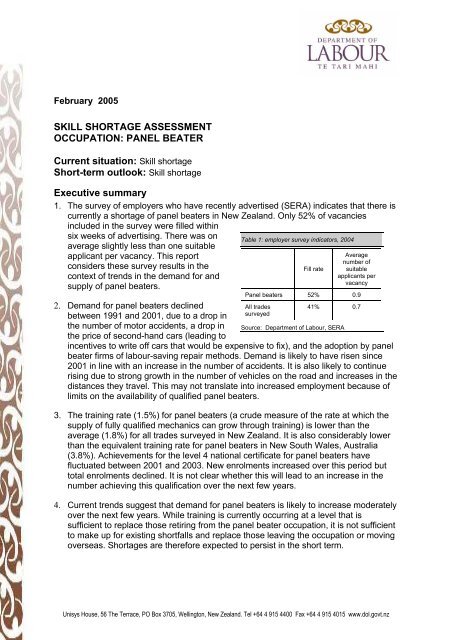
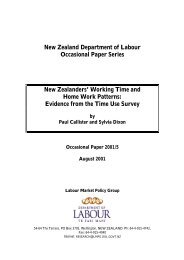

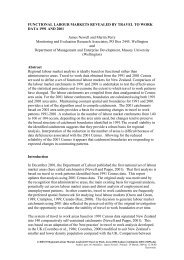
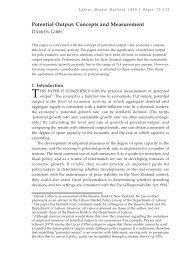

![a note on levels, trends, and some implications [pdf 21 pages, 139KB]](https://img.yumpu.com/27285836/1/184x260/a-note-on-levels-trends-and-some-implications-pdf-21-pages-139kb.jpg?quality=85)


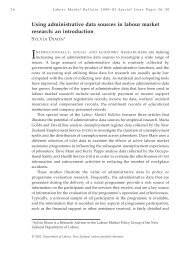

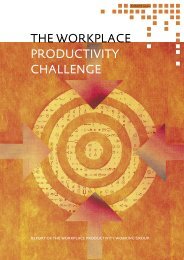
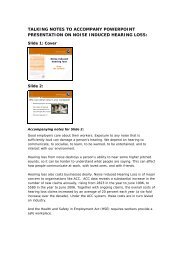
![Labour Market Trends and Outlook - 1996 [pdf 18 pages, 94KB]](https://img.yumpu.com/27285764/1/184x260/labour-market-trends-and-outlook-1996-pdf-18-pages-94kb.jpg?quality=85)

